Demos | |
|
|
|
|
More information under: Denis Lalanne home page . This page is no longer updated on a regular basis. More projects descriptions are available here: master projects in DIVA group and here: research project in DIVA group. |
|
|
|
|
The EmotiBoard (2014) |
Denis Lalanne Fabien Ringeval |
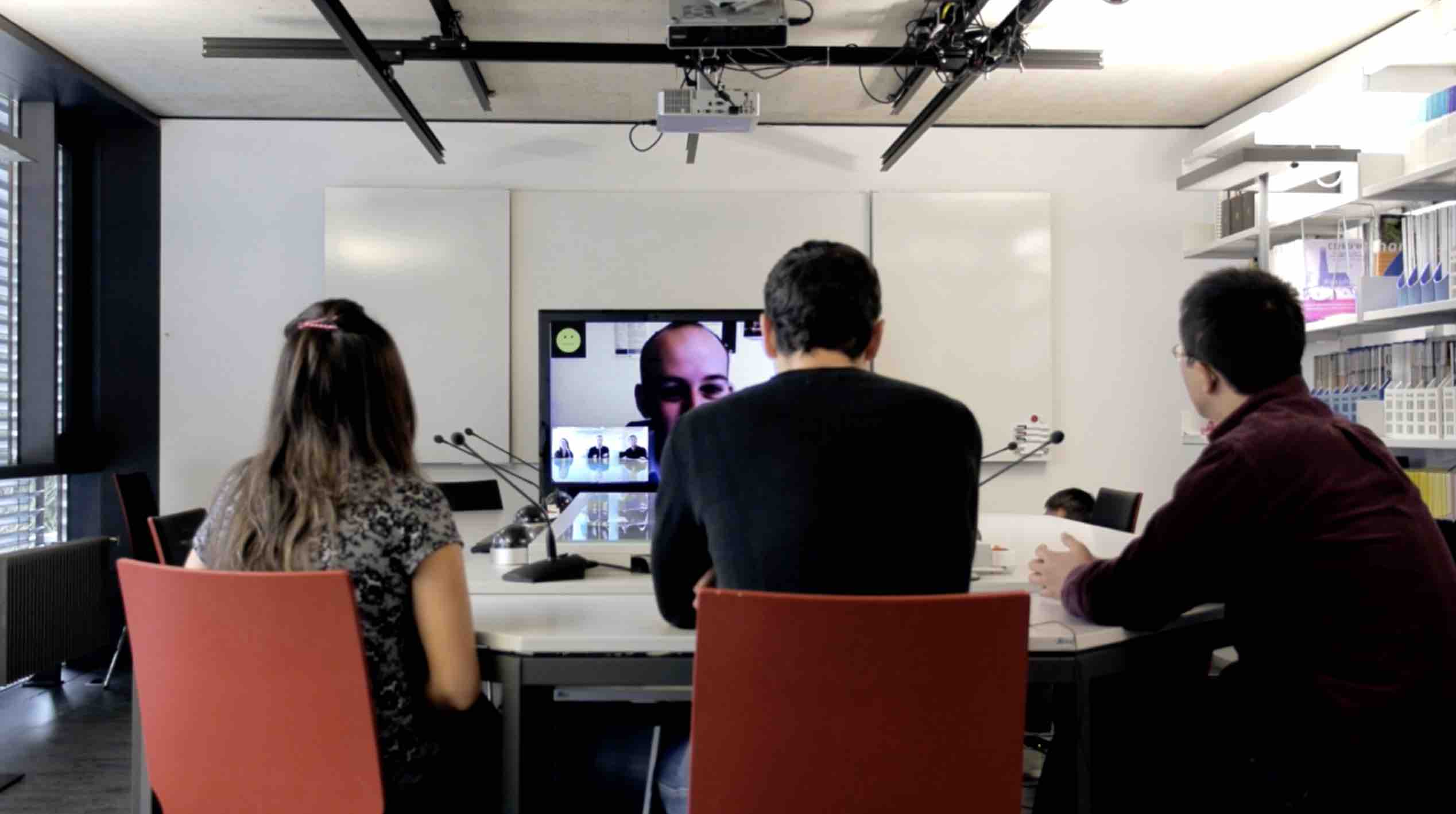
|
The Communication Board - EmotiBoard is an interdisciplinary project, leaded by Denis Lalanne and Fabien Ringeval at the department of Informatics and in collaboration with Prof. Juergen Sauer and Andreas Sonderegger from the department of psychology. The goal of this project is to develop a methodology for emotionally enriching remote collaborative interactions; members of virtual teams are indeed less productive and less affectively committed compared to collocated teams, in particular with regard to difficult work situation such as intercultural teamwork. The project involves both real-time emotion recognition from multimodal inputs (speech and electrodermal activity - EDA) and adapted emotional visual representation as an emotion feedback; one see the emotion of his/her remote partner. Various studies were performed with EmotiBoard to investigate its benefits for improving quality of remote collaborative interactions with an emotional feedback, in particular for emotion awareness (i.e. accuracy in perception of remote teammate’s emotion) and social behaviors like agreement, engagement, dominance, performance, rapport, etc. .
|
|
|
|
Visual Analytics for All (2012) |
Student: Ilya Boyandin Supervision: Denis Lalanne Supervision: Enrico Bertini |
|
The overall goal of the Humanitics project, financed mainly by the Swiss National Science Foundation, is to develop visual analytics tools for public organizations to enhance collaborative knowledge discovery, information exchange and communication. It was initiated as a collaboration between the University of Fribourg and the United Nations in Geneva. Each year, the United Nation manipulates and reports numerous data and information concerning world-wide health, illicit drug trade, environment and global climate change, diseases, energy, conflict, and humanitarian development concerns. The UN urgently needs authoring tools to analyse these data and cross correlate them in a visual way, not only to improve visual understanding, but also for analysts to produce meaningful visualizations to present their findings. As a first attempt, the project concentrated on the visualization of migration data over time. JFlowMap is the current research prototype developed at the University of Fribourg to explore and evaluate spatio temporal flow map visualization techniques. Screenshots and videos can be found on here.
|
|
|
|
Tabletop MindMap (2007) |
Student: Karin Altorfer Supervision: Denis Lalanne |
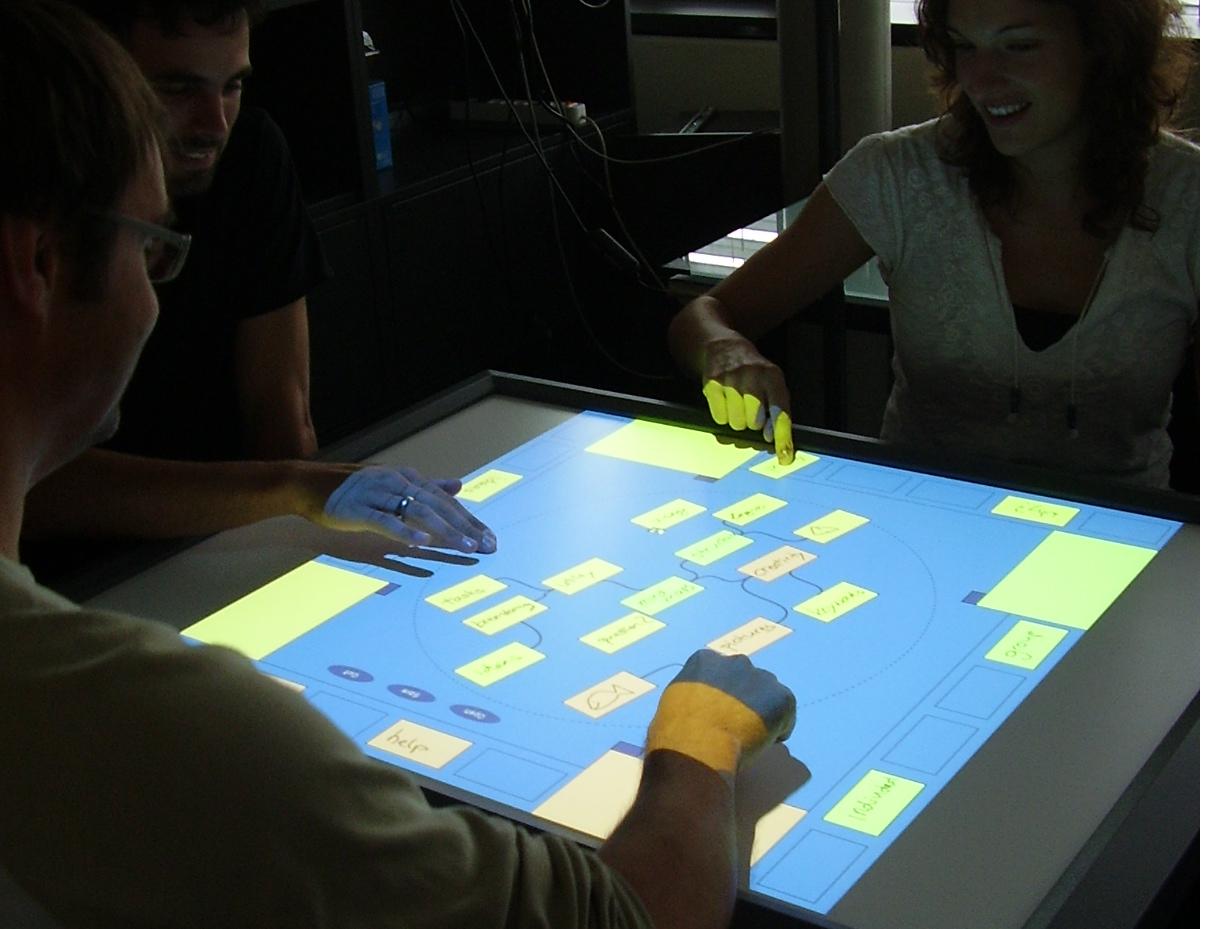
|
The TableMind is a tabletop application that supports collaborative mind mapping. It takes advantages of physical and digital worlds for collaborative tasks.
The TableMind application runs on a Diamond-Touch table developed by MERL for small group collaboration. The members of the group sit around a touch-sensitive display consisting of different columns and rows of antennas. The graphical image is projected with a beamer fixed above the table. Every user sits on a receiver pad through which a very low current is flowing. When the user touches the display while he is in touch with a receiver pad, an electrical circuit is closed and the system detects which user is touching the table at which location.
The four members of the group sit around the table. The graphical user interface is covering a quadratic surface consisting of several different zones, each type of zone interpreting user input differently. Every user has a virtual Post-it block in the right-hand corner in front of him where he can create, write and draw an unlimited number of Post-its. He can then use the small handle to either drag these Post-its directly onto the mind map area in the center of the surface or stock (currently) up to five Post-its in the private storage area in front of him. The mind map area in the middle of the table is the common working space where the users create and discuss their mind map. This circular zone is rotatable. Post-its can be linked by overlapping them for a short fraction of time. Linked Post-its can then be freely moved within the mind map area whereas the linkage is updated automatically. The only buttons existing in the proposed interface are an open, save and exit button to trigger the corresponding actions.
|
|
|
|
Fridoc (2005) | Authors: Denis Lalanne, Didier von Rotz |
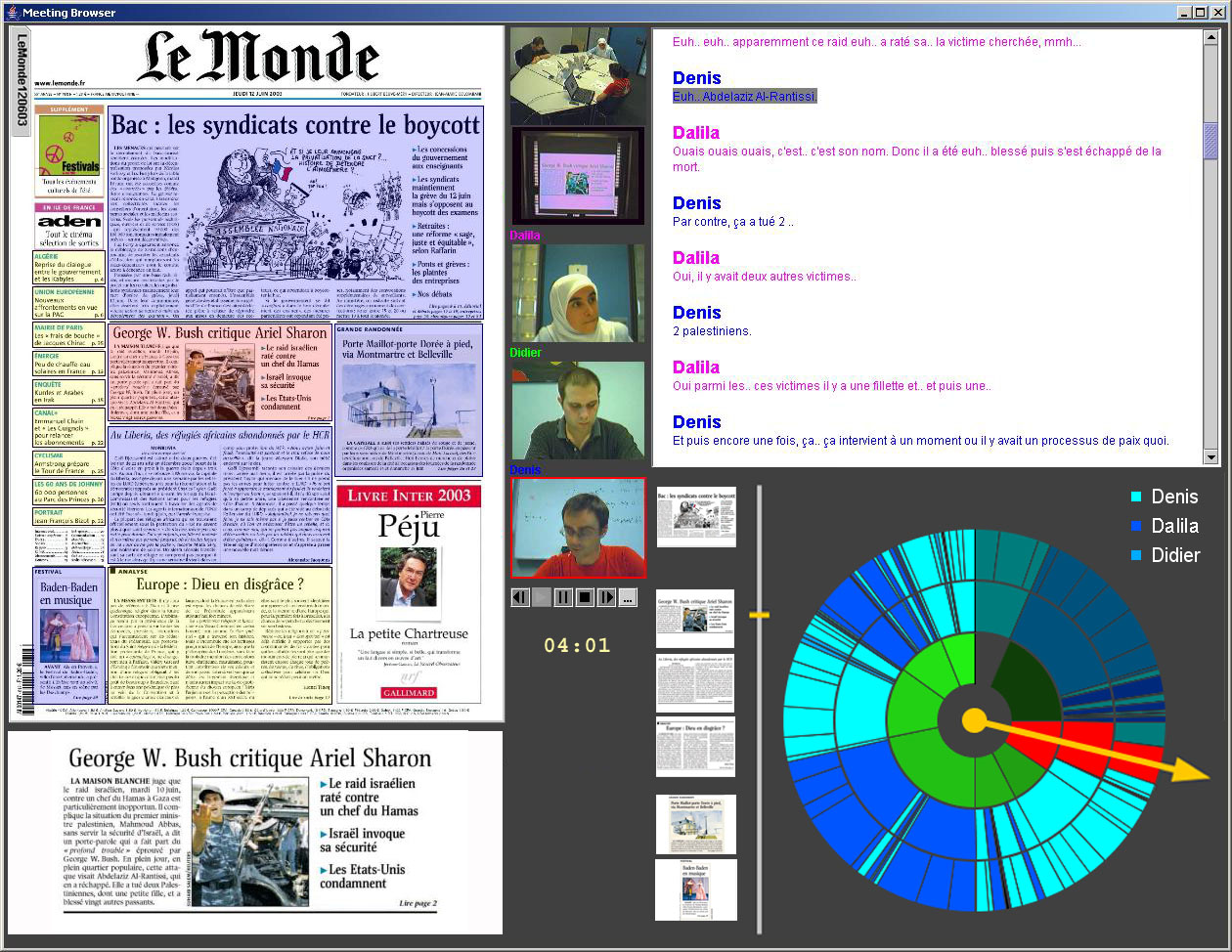
|
Our prototype of document-centric multimedia meeting browser is illustrated in figure 1 and then on figure 2. First of all, figure 1 presents our cross-meeting browser, allowing a thematic search and browsing on a multimedia archive. All the newspaper articles, stored in the press reviews archive, are plotted on the visualization according to user request (e.g. Bush, Irak, Sharon, etc.). The most relevant articles are returned by the system and organized spatially according to the user keywords; the higher is an article, represented as a white circle, on the visualization, the more it contains user keywords and thus answers the user request. Further, the relative participation of each keyword is represented using histograms. The horizontal axis represents the date of the meeting in which the article was projected or discussed. This way, the visualization also indicates the evolution of a theme throughout the time. On the same visualization, the speech transcript for each meeting, represented as a black circle, is plotted following the same visualization rules. In fact, this cross-meeting browser allows visualizing quickly an important number of meetings, and favours a thematic browsing of the meeting archive, using not only the meetings speech transcript but also the content of the documents, discussed or projected during the meetings, as entry points to the meeting archive.
|
|
|
|
JFridoc (2006) | Authors: Maurizio Rigamonti, Denis Lalanne, Rolf Ingold |
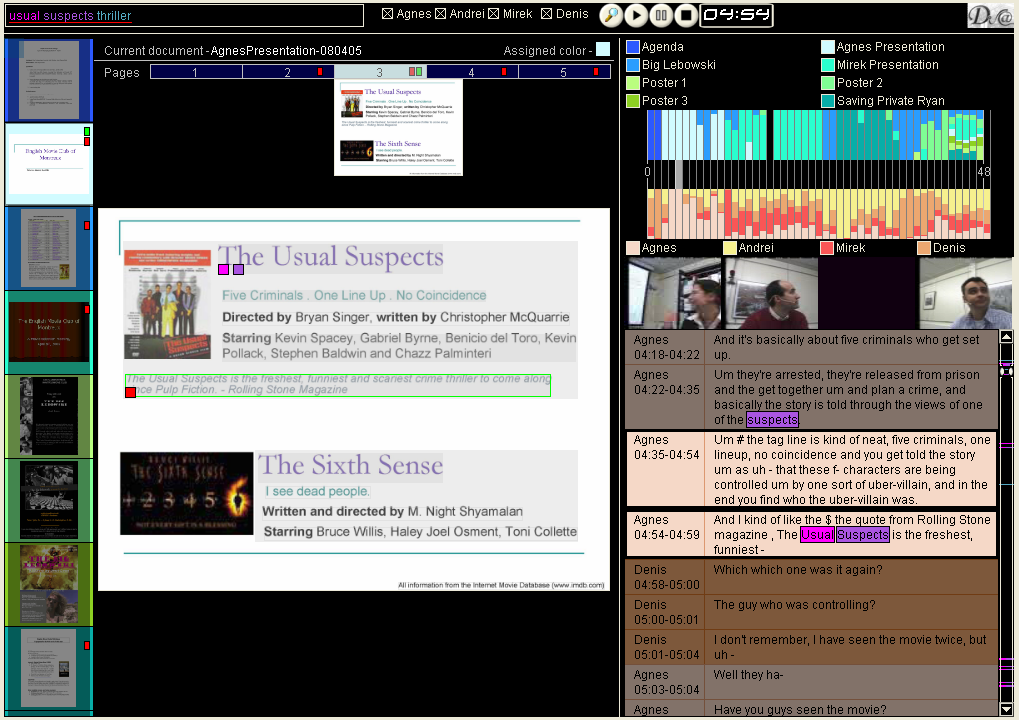

|
Similarly to FriDoc above, JFriDoc is a document-centric meeting browser, based on the JFerret framework, that will be used for the Browser Evaluation Test (BET) in the context of IM2 and AMI projects. The BET aims at evaluating single components of browsers centered on different media and individual modalities, in order to estimate their efficiency for multimodal navigation.
JFriDoc does not only consist of an adaptation of his ancestor, but it also explores novel concepts. In fact, JFriDoc abandon cross-meeting navigation in favor of extra-functionalities provided at the intra-meeting level, in order to handle larger meetings. Moreover, the meetings visualized in JFriDoc contain data and annotations that present various semantic links and overlaps: for example, an article might have been discussed several times and various participants could have been speaking at the same time. Managing more realistic data implies new visualizations for representing 1) multiple alignments between static document and speech; 2) relationships between discrete time and meeting; 3) overlapping of media at same time; and 4) multiple results to queries submitted by users.
|
|
|
|
Tjass (2006) |
Student: Mathias Muller Supervision: Florian Evequoz, Denis Lalanne |
|
TJASS, A SMART BOARD FOR AUGMENTING CARD GAME PLAYING AND LEARNING. The goal of Tjass is to extend card gaming with computational aids in a non intrusive and transparent way to support both beginner and expert players and to enrich their gaming experience. Tjass beginners assistance is directly available on the game board. In the traditional jass card game the players have to count and notate manually the scores. As well they need to observe continuously the status of the score to determine the winner team. In addition the rules of jass are complex and require keeping in mind the overview of all played and remaining cards. Therefore beginners often have difficulties to learn the game. Tjass will disburden the players of these tasks by (1) counting and displaying the score automatically in real time and (2) putting at beginners disposal a decision assistance to teach them the game.
|
|
|
|
Elcano (2006) |
Student: Herve Chiquet Supervision: Florian Evequoz, Denis Lalanne |
|
ELCANO, A TANGIBLE MULTIMEDIA BROWSER AND ORGANIZER-
The goal of the Elcano project was to develop a simple tangible browser providing original views of the multimedia content of a storage medium, facilitating navigation using tangible sorting and filtering mechanisms and interactive visualizations. In this case, a memory stick is used as storage medium to provide mobility to the user.Elcano provides interactive visualizations to ease navigation through a great quantity of documents. To navigate in the views, physical widgets are used. Sorting and filtering algorithms as well as binding to personal objects are activated using physical tokens augmented with RFID tags.
|
|
|
|
Phong (2006) |
Student: Mehdi Radgohar Supervision: Florian Evequoz, Denis Lalanne |
|
PHONG, AUGMENTING VIRTUAL AND REAL GAMING EXPERIENCE-
The goal of the Phong project, contraction for Physical Pong, is to implicate players physically in digital games. Tangible user interfaces have proved to be an intuitive and natural mean of interaction, particularly useful to reduce the gap between digital and physical worlds, since objects can co-exist in both dimensions. The purpose of Phong is to add both physical elements to the virtual world and virtual elements to the real world, making it a good example of mixed reality system.
|
|
|
|
FaericWorld (2007) | Authors: Maurizio Rigamonti, Denis Lalanne, Rolf Ingold |
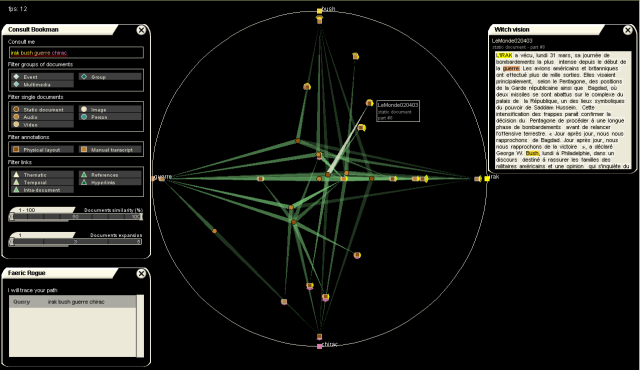
|
FaericWorld is a multimedia browser, which intends to visualize a large collection of heterogeneous multimedia documents. The major issues of FaericWorld are: 1) the cross-media navigation; 2) the validation of annotations on media and of links between documents; 3) the abstraction and creation of new documents, by hyper-linking existing ones.
The archives imported, analyzed, and indexed by FaericWorld browser are composed of media (static documents, images, videos, or audio recordings), multimedia documents (slideshows or websites), people (person name, its publications, etc.) and events (conferences, meetings, etc.)
|
|
|
|
SpiralView (2007) | Authors: Enrico Bertini, Patrick Hertzog, Denis Lalanne |
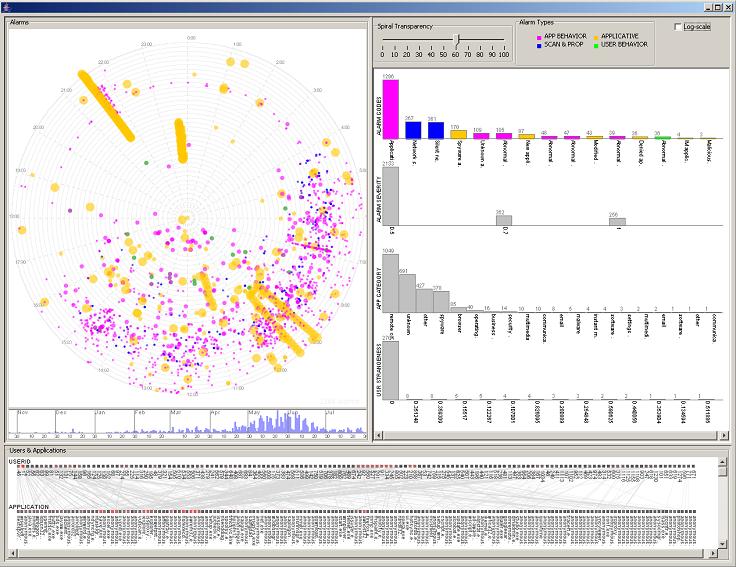
|
The SpiralView is a visualization tool for helping system
administrators to assess network policies. The tool is meant to
be a complementary support to the routine activity of network monitoring,
enabling a retrospective view on the alarms generated during
and extended period of time. The tool permits to reason about
how alarms distribute over time and how they correlate with network
resources (e.g., users, IPs, applications, etc.), supporting the
analysts in understanding how the network evolves and thus in devising
new security policies for the future. The spiral visualization
plots alarms in time, and, coupled with interactive bar charts and a
users/applications graph view, is used to present network data and
perform queries. The user is able to segment the data in meaningful
subsets, zoom on specific related information, and inspect for
relationships between alarms, users, and applications.
|
|
|
|
XPaint (2006) |
Students: Luca Zingg, Daniele Della Bruna et Yannick Thiessoz Supervision: Denis Lalanne, Omar Abou Khaled |
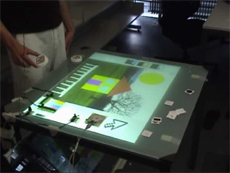
|
X-Paint is an augmented table supporting tangible drawing activities. The interaction consisits of fast and easy to learn gesture that support two-handed control. The table allows the user to interact in a multimodal fashion, combining tangible interaction and voice recognition.
The user can choose the colour and the size of the pen he/she wants to use by using multiple phidgets sliders and the rotation sensor. The user can choose the shape he/she want to draw by selecting the corresponding RFID-enabled object. Finally the user can use some vocal commands such as "begin draw", "select shape", "rotate shape" to perfom different drawing actions.
|
|
|
|
ShareDesk (2006) |
Students: Michel Yerly, Elia Palme, Fabrice Bodmer Supervision: Denis Lalanne, Omar Abou Khaled |

|
Share Desk is an augmented table supporting information sharing activities. Users can authenticate themselves via a RFID-enabled card and then access their collection of personal information (pictures, audio and text files), which is visualized on the table. By using a touch rotation sensor users can navigate within folders. Moreover the Sharing Desk provides a voice-based interaction modality which allows the user to open and close file folders, to exchange information and play some music.
|
|
|
|
Inquisitor (2005) |
Student: Florian Evequoz Supervision: Maurizio Rigamonti, Denis Lalanne |
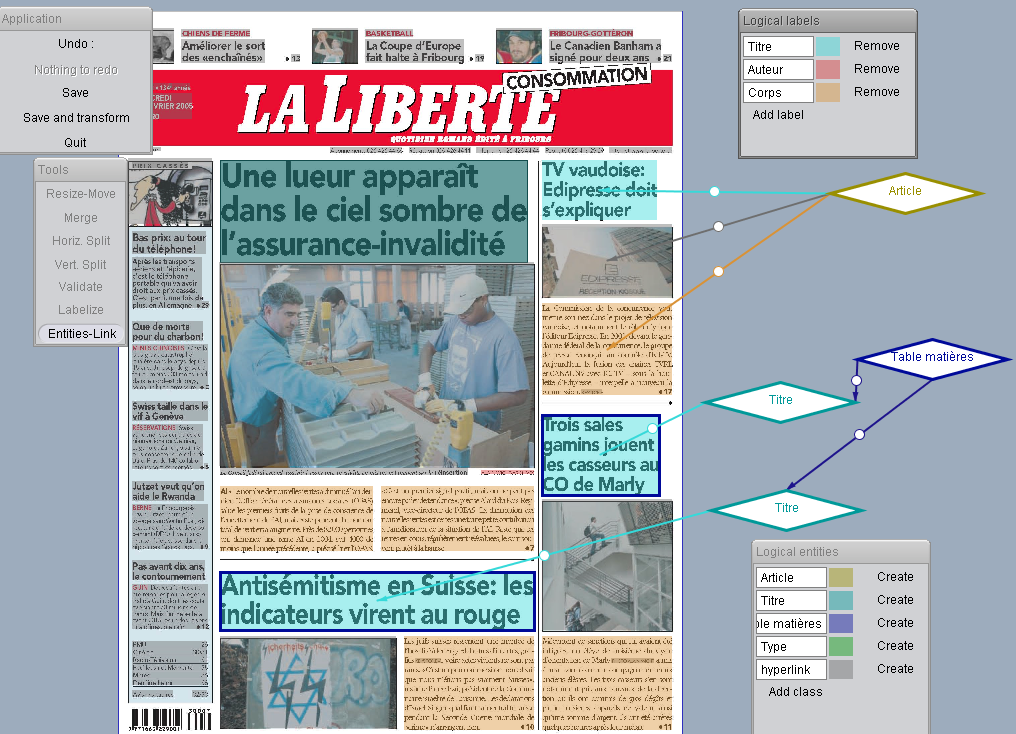
|
Inquisitor is an interface using heretix API that has been developed in order to correct document analysis results, in particular of Xed, on the basis of previous experiences. Inquisitor not only supports annotations correction, but it allows also to create manually new annotations on static documents further useful for creating links with other media in Faericworld.
|
|
|
|